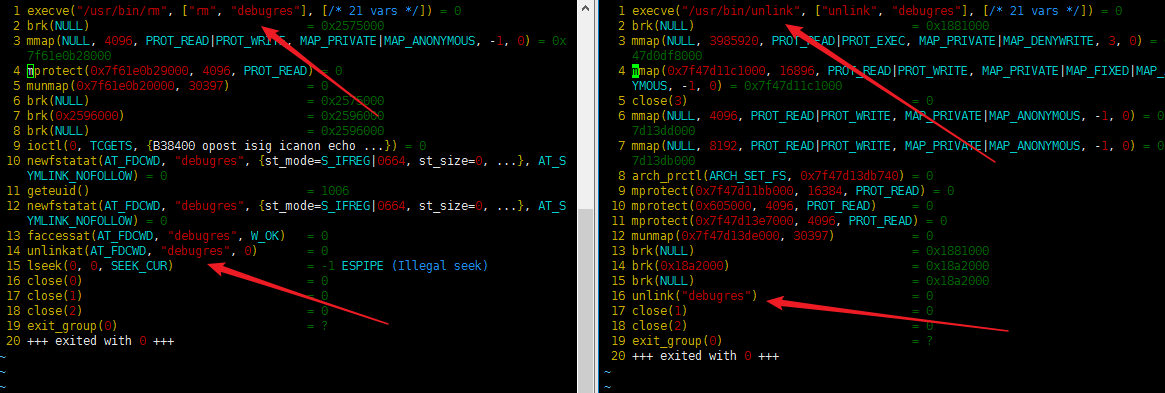目前看以前的代码想到一个问题,unlink rm 区别 和和 close 的区别!
主要场景是 想使用 文件大内核锁进行多进程互斥!
多进程中使用 文件锁互斥方式如下:
mtx->fd = open_file(file_name); mtx->name = file_name; fork()
也就是fork 后 进程都用这个文件的fd 然后根据文件fd 的文件锁进行互斥访问!!
当然 多进程 访问 fd 的文件锁时 可以根据需要 设置不同的获取锁规则!比如 可以实现类似于spin_lock try_lock的动作
trylock_fd(fd_t fd) { struct flock fl; memzero(&fl, sizeof(struct flock)); //这个文件锁并不用于锁文件中的内容,填充为0 fl.l_type = F_WRLCK; fl.l_whence = SEEK_SET; /* 使用F_SETLK lock_fd方法获取互斥锁成功时会返回0,否则返回的其实是errno错误码,而这个错误码为NGX- EAGAIN或者NGX EACCESS时 表示当前没有拿到互斥锁,否则可以认为fcntl执行错误。 */ if (fcntl(fd, F_SETLK, &fl) == -1) { return ngx_errno; } return 0; } /* lock_fd方法将会阻塞进程的执行 */ lock_fd(fd_t fd) { struct flock fl; memzero(&fl, sizeof(struct flock)); //F_SETLKW 会导致进程睡眠 fl.l_type = F_WRLCK; fl.l_whence = SEEK_SET; //如果返回-1,则表示fcntl执行错误。一旦返回0,表示成功地拿到了锁 if (fcntl(fd, F_SETLKW, &fl) == -1) { return ngx_errno; } return 0; }
参考文件:https://man7.org/linux/man-pages/man2/fcntl.2.html
F_SETLK (struct flock *)
Acquire a lock (when l_type is F_RDLCK or F_WRLCK) or
release a lock (when l_type is F_UNLCK) on the bytes
specified by the l_whence, l_start, and l_len fields of
lock. If a conflicting lock is held by another process,
this call returns -1 and sets errno to EACCES or EAGAIN.
(The error returned in this case differs across
implementations, so POSIX requires a portable application
to check for both errors.)
F_SETLKW (struct flock *)
As for F_SETLK, but if a conflicting lock is held on the
file, then wait for that lock to be released. If a signal
is caught while waiting, then the call is interrupted and
(after the signal handler has returned) returns
immediately (with return value -1 and errno set to EINTR;
see signal(7)).
man7 中可以看到解释!!
由于此时只是需要多进程的互斥 所以一般是 open fd 后 就回调用unlink 删除此文件!!
对于 守护进程中使用 文件锁 来保证 单一进程拉起时, 此时不需要删除文件!!
对于 unlink 和 rm close 关系
下面是来之网上的一段话!!认为是对的 !!
对于 rm 和unlink的区别!
见这篇文章:https://unix.stackexchange.com/questions/151951/what-is-the-difference-between-rm-and-unlink

POSIX specifies that the unlink utility calls the C library unlink function and nothing else. It takes no option. If you pass a valid path name to something which isn't a directory, and if you have write permissions to the directory where that object lives, then unlink will remove it.
rm is a traditional Unix command which has a bit of other functionality, and isn't quite a superset of unlink (see below).
Firstly, rm performs safety checks. If you try to rm an object to which you don't have write permissions (which are irrelevant to your ability to remove it: the containing directory's permissions are!) rm nevertheless refuses unless -f is specified. rm normally complains if the file doesn't exist, as does unlink; however with -f, rm does not complain. This is often exploited in Makefiles (clean: @rm -f $(OBJS) ...) so make clean doesn't fail when there is nothing to remove.
Secondly, rm has the -i option for interactively confirming the delete.
Thirdly, rm has -r for recursively removing a directory, which is something that unlink isn't required to do, since the C library function doesn't do that.
The unlink utility isn't exactly a stripped-down rm. It performs a subset of what rm does, but it has semantics which is a combination of rm with -f and rm without -f.